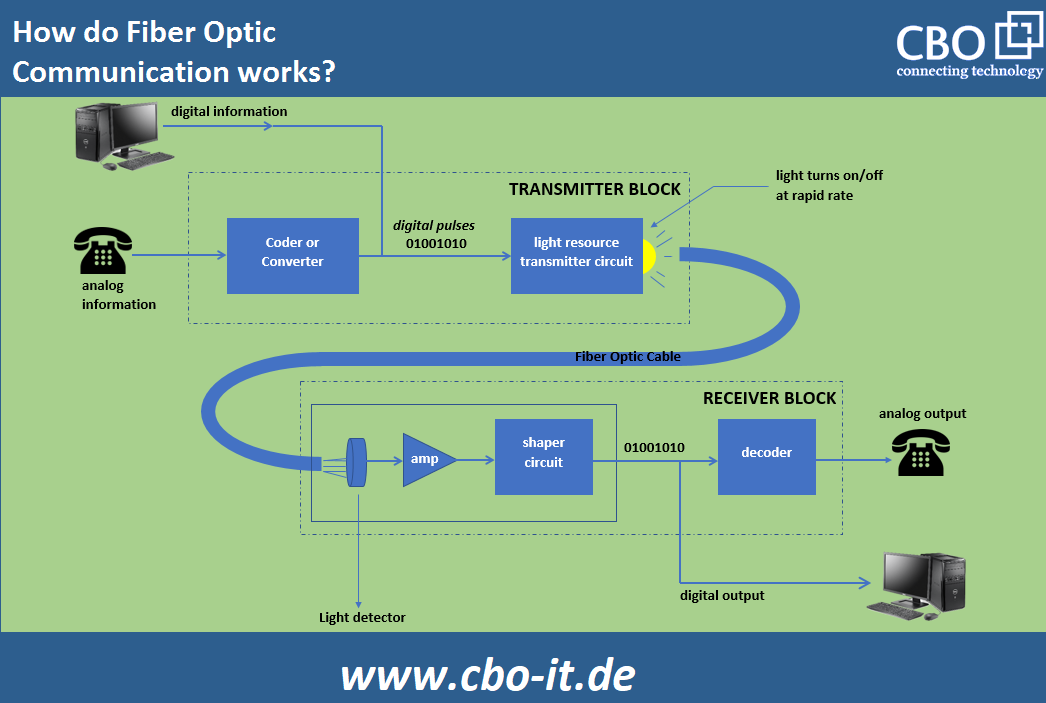Transmission is at the height of progress and flourishing day by day, which shows it will change telecommunication effectively. According to the statistics, global optics fiber was valued at about USD 2.75 billion in 2016. Fiber optic transmission is becoming popular daily due to its intensive use in the industrial and residential sectors. This blog will discuss the pros and cons of optic fiber in detail. So, what are you waiting for? Let's go ahead.
Introduction to fiber optic technology:
There are three main components of an optic communication system
- Fiber optic cable
- An optical receiver
- Optical transmitter
The optical transmitter does the conversion of electric signals to optical signals. Then these signals are carried out to the optical receiver, where they are again converted to electric signals. The frequently used optical transmitter is semiconductor diode such as laser diode and LED. The primary component of an optical receiver is a photodetector. The process of development of optic fiber is just marvelous nowadays. Many optical fibers are available in the market, like OS2 fiber, OM1 fiber, OM2 fiber, OM3 fiber, OM4 fiber, and OM5 fiber cable. They are usually preferred for long-distance transmissions due to their excellent light propagation. The following explains the basics of optical fiber transmission;

Pros of fibers optical transmission
This technology has effectively replaced copper wire communication all around the world. It is highly advantageous over other transmission systems. There are a lot of other benefits of optical fiber like:
- they are composed in such a way that they are low weighted hence easy to install
- provides enhanced bandwidth to further accommodation of optical fiber
- as far as there is a concern of diameter, they are small and have a low diameter. The diameter of optical fiber is about 2mm
- for long-distance transmission, they are a good choice due to their low power loss capacity
- they are highly resistant to electromagnetic interference
- excellent bandwidth of optical fibers is impressive that is making it a preferable source over copper wire
-
optical fibers provide reasonable security to your data; there is no way to change or leak information, which is why it ensures good security
Cons of optical fiber transmission:
Despite many benefits, there are some disadvantages of optical fibers that cannot be ignored at all, such as:
- As optical fibers are made of glass, they're highly fragile and can be broken even by slight pressure applied. They are highly affected by any type of chemicals like hydrogen and others, which raises questions about their reliability
- Sometimes that creates serious problems with installations because they cannot be bent significantly; hence installation is a complicated process
- During transmission at the longer distance, the chance of light attenuation increased, putting the data at risk
- Customers usually prefer low-cost material, but optical fibers are expensive, creating a burden on your pocket by disturbing your hard meet the budget. installation of optical fibers cost more than copper wire
- Optical fibers need extra care and extra pieces of equipment like power meter and optical probes etc. for their working and maintenance as well
Final verdict:
Optical fibers have brought a revolution in the networking industry. Fiber cables are far better than copper cables in various aspects. These cables enabled us for long-distance connectivity that was impossible with copper cables. There are some cons related to optical fiber transmission as well. However, the continuous evaluation of optical fiber technology makes it more user-friendly, efficient, and effective with time. For domestic users, copper can work as well as fiber. So, it is your call! You can decide whether to go with copper or fiber-based on your requirements, budget, and other factors.
 English
English
 Deutsch
Deutsch
 Espaniol
Espaniol










